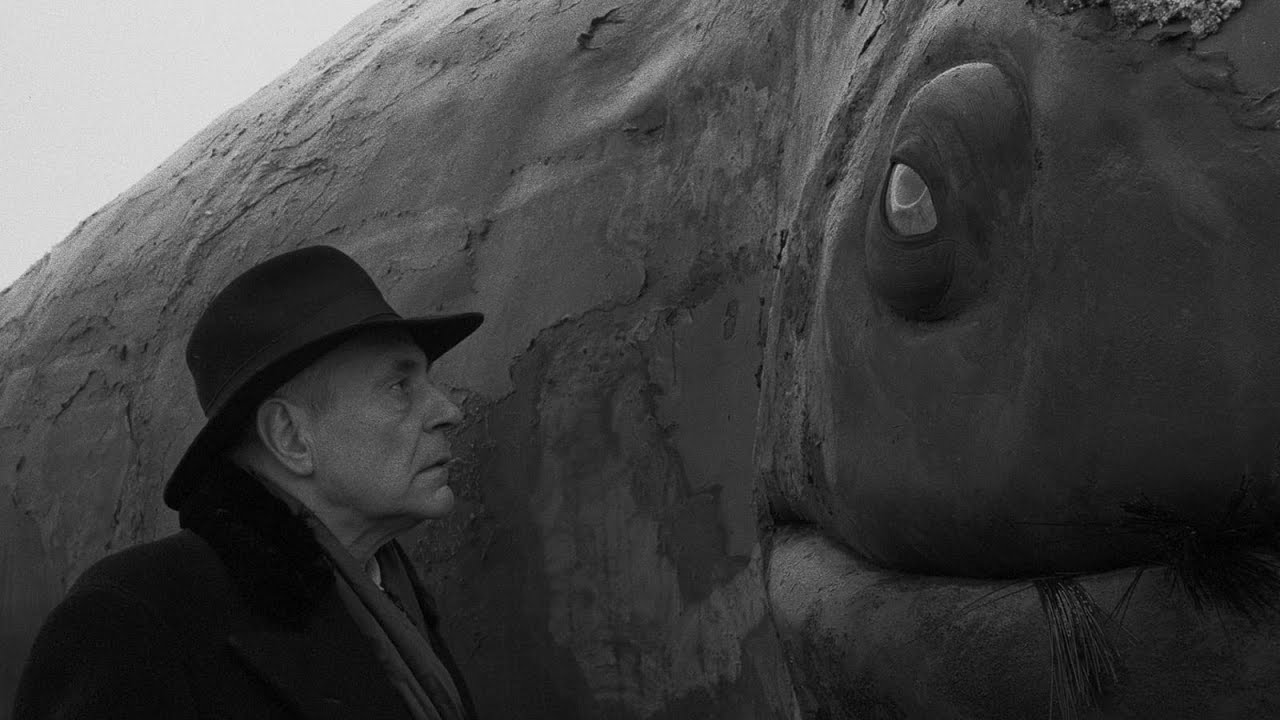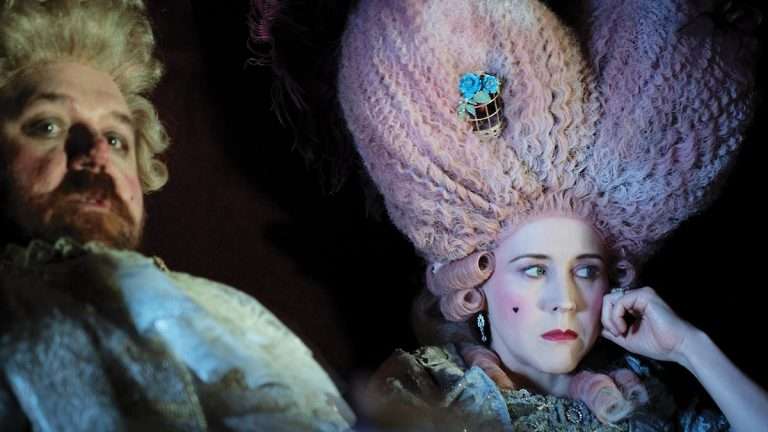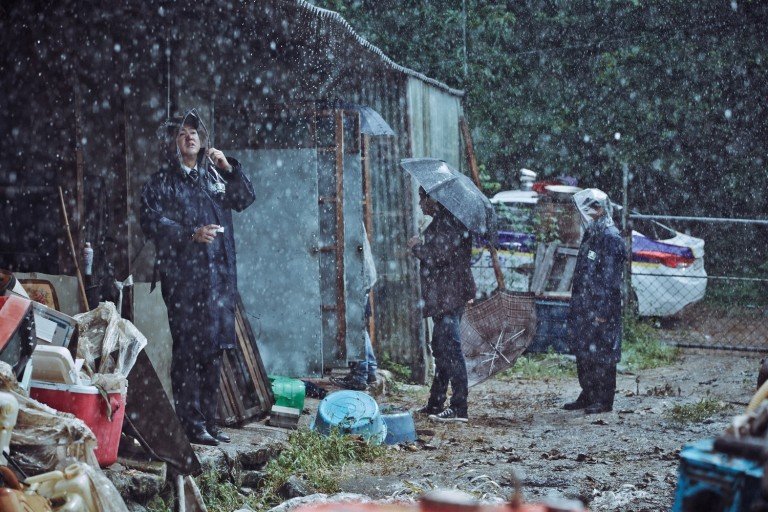Béla Tarr’s “Werckmeister Harmonies” (Original title: “Werckmeister harmóniák,” 2000) is a haunting exploration of the fragility of order and the allure of chaos, rendered through an uncompromising cinematic language that transcends narrative expectations. I rewatched this film recently and ended up watching it twice within the span of a weekend.
Released in 2000 and based on the novel “The Melancholy of Resistance” by László Krasznahorkai, the film is one of the most austere and philosophically rich contributions to world cinema. The cinematography emerges as the film’s true marvel. Tarr’s vision is uncompromising, his execution meticulous, and the imagery unfurls with the patience of a candle slowly burning down. The world he builds is hypnotic in its immersion, so that when chaos finally erupts, it detonates with the sudden force of a champagne cork bursting free.
At its core, “Werckmeister Harmonies” is not about a plot in any conventional sense. It follows János Valuska, a stoic figure who drifts through a bleak Hungarian town as strange forces begin to converge. A traveling circus arrives, bringing with it a mysterious attraction, a giant, decomposing whale, and a shadowy figure known only as “The Prince.” What begins as an almost surreal, dreamlike observation of small-town life subtly transforms into a study of social breakdown, paranoia, and violent upheaval. The film is composed of just thirty-nine shots across its 145-minute runtime, and this structural decision is crucial to understanding Tarr’s approach.
Rather than cutting rapidly between angles or constructing sequences through montage, Tarr allows the camera to move with a graceful patience, gliding through scenes as if observing like a ghost. These long takes dominate the film, many of them executed with smooth tracking shots that follow characters through fog-filled streets and dilapidated interiors. Each shot is its own complete unit of cinematic experience, allowing time to stretch and breathe. This rejection of fast-paced editing forces the viewer into a slower, more contemplative rhythm, one that mirrors the bleak apathy of the world on screen.
Fred Kelemen’s cinematography is seared into memory—inseparable from the film itself, alongside its haunting score. Shot in stark black and white, each frame becomes a painting: shadows sinking deep, diffuse light catching on crumbling facades, weary faces, and streets forever drenched in mist. Decay saturates the images, as if the town itself were rotting from within—a corrosion not merely of stone and mortar but of spirit. That visual disintegration mirrors the slow, inexorable unraveling of the society at its core.
What Tarr achieves through this cinematic language is a sense of heightened reality. It’s not surrealism, exactly, but a kind of bleakness that evokes a world suspended in stasis, waiting for something unspeakable to erupt. That eruption comes in the form of chaos, sparked by the arrival of the circus and the unseen Prince, whose mere presence seems to catalyze a kind of collective hysteria.
The townspeople, already teetering on the edge, begin to murmur of conspiracies and revolution. Eventually, these murmurs explode into a violent spectacle. A mob invades a hospital in a terrifying sequence rendered with excruciating slowness and dread. It’s a demonstration of how the line between order and anarchy can be erased in a single gesture.

Also Read: 20 Best Black and White Movies of the 21st Century
And yet, Tarr never offers easy explanations. We are meant to witness. To contemplate. The Prince, for all his influence, never appears onscreen. The whale, a grotesque and magnificent corpse, is dragged around the town like a relic from a collapsed civilization. Both become symbols in the film, not of anything concrete, but of existential dread, of the way that spectacle can incite and manipulate human behavior.
The film’s strength lies in its ambiguity. What engulfs the town is not revolution but dissolution, a slow fracturing rather than a call to arms. The mob is bound not by vision but by fear, lured forward by the intoxication of destruction. Tarr seems to whisper that civilization is only a thin crust stretched over something raw and primal—a drive to raze everything, not in pursuit of renewal but from a well of despair. He refuses to moralize this impulse, instead capturing it with the same cold, patient gaze that follows a lone man crossing a frozen square or a weary crowd drifting into darkness.
János, as the film’s central figure, is both a participant and an outsider. He seeks understanding in a cosmic harmony that he glimpses in the orbits of planets. The film opens with one of cinema’s most mesmerizing sequences: János guiding a drunken crowd into a clumsy yet haunting reenactment of a solar eclipse. In this strange choreography, he seems to be reaching for proof of cosmic order—trying to convince them, and perhaps himself, that the universe still holds meaning. It is a fragile, melancholy vision, the final glimmer of hope before the storm breaks.
But peace is impossible in a world that no longer believes in it. The title itself references Andreas Werckmeister, a 17th-century music theorist who attempted to rationalize musical scales into mathematical perfection, an attempt to impose order on the dissonance of sound. Tarr’s film questions whether such harmony is ever achievable in human society, or whether the very structures we build to maintain order inevitably give way to the chaos they try to contain.
The conclusion of “Werckmeister Harmonies” offers no clear resolution. The whale is still there, a hulking reminder of death and wonder, and János retreats into silence. The town remains shrouded in mist, the future uncertain. In a way, the film ends where it began, with a sense of suspended time. But something has changed. The atmosphere is heavier. The hope, if it ever existed, has been smothered. “Werckmeister Harmonies” is not a film for those craving speed or spectacle. It asks for patience, and in return reveals a profound meditation on a society at the edge of collapse. Its execution carries the hazy, unsettling texture of a dream.


![The Woman Who Ran (Domangchin yeoja) [2020] Review – A truly minimalist tribute to the female gaze](https://79468c92.delivery.rocketcdn.me/wp-content/uploads/2020/03/The-Woman-Who-Ran-768x405.png)




![Haxan [1922] Review – A Bewitchingly Bizarre and Rationalistic Take on the Horrors of Middle Ages](https://79468c92.delivery.rocketcdn.me/wp-content/uploads/2020/03/Haxan-1922-768x432.jpg)
Great film, I recommend watching the 7 hour ‘satantango’ if ever given the chance.